Catalina Park… much missed
by Brian Goulding
In December 2015 my wife and I spent an enjoyable couple of days at an old fashioned guest house at Katoomba in the Blue Mountains. We were with another couple and on one rainy morning both wives wanted to go shopping. I saw this as a golden opportunity to take my friend Pete for a walk around what was left of the Catalina Park racing circuit which I had not visited for about 30 years.
We found the area about a kilometre southwest of the shopping centre. The whole circuit and its surrounds are now a nature reserve and the site is overgrown to the extent that a tree canopy has formed over the track in several places. The original access road to the pit area (through two gates in the wooden safety fences) remains, but it is only used for emergency vehicles. Twenty metres further around the corner another opening has been cut in the outside safety fence with appropriate flags and message boards welcoming visitors to The Gully, a former aboriginal camping/dwelling area.
We walked onto the circuit down a slight slope onto the starting grid. To our left, on a higher level than the track, was the paddock area shown as “pits” on the circuit map printed in race programmes. Except, there was never a pit lane. The paddock area at Catalina race meetings was organised in a simple yet effective way. Row one on the grass was for racing cars, row two for sports cars and row three for touring cars.
The old two storey, white control tower, which once stood in the middle of the circuit, has been replaced by a modern brick cottage that’s used by today’s custodians of the circuit as an administration building. On the road leading from the grid to the admin building is a row of mounted photographs intended for visitors. Of the 10 photographs, the last three are racing shots. Above these is a quote from a prominent person – “It was disgusting. They just bulldozed everything to make the racing circuit”.
The Gully (Catalina Park) was officially made an aboriginal place in 2002. It is a shame that motor racing has been made the villain in what was obviously a sorry saga.
The name Catalina Park came from the outdoor amusement centre built by a local entrepreneur in the 1950s. By damming a creek, they created a large swimming pool that was also used for boating. A miniature scenic railway was installed and as an extra attraction a WWII Catalina PBY Catalina flying boat was moored in the centre of the pool. The pool is still there, the Catalina long gone.
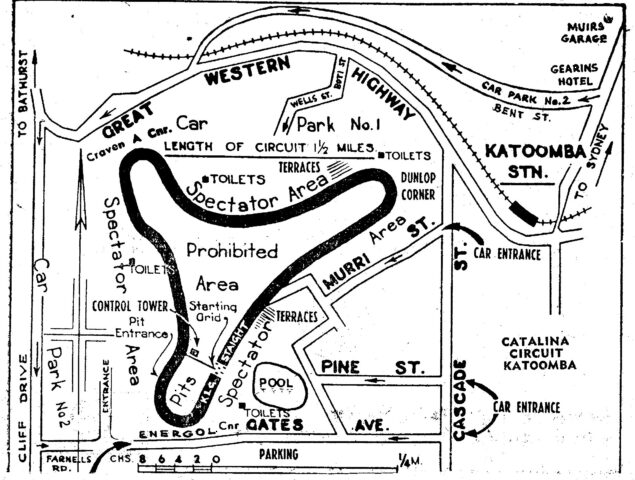
Back to our circuit walk. We set off from the starting grid along KLG Straight as the dark sky began to spit rain. The circuit shape is best described as a triangle with rounded points and each side slightly squeezed in. The starting grid is the lowest point on the circuit but soon becomes a short and steep hill which put cars on a higher level for the straight run to Dunlop Corner, a sweeping left hander. At the top of this rise is the start of safety fencing on both sides of the paved surface. Initially all of the fencing was wooden, about one metre high. As the 1960s progressed some of the wooden fencing was replaced by single layer Armco, installed at about axle height, with a gap between the track and the bottom edge of the Armco. Both the wooden fencing and the Armco are still in situ today.
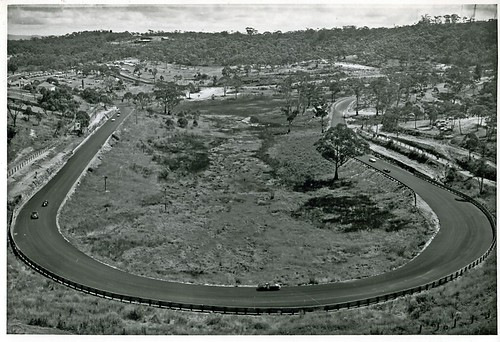
As we walked along KLG Straight it started to rain proper and we broke out the umbrellas. By the time we reached Dunlop it was hailing and Pete wanted to turn back. I told him we were more than half way around (which we were not) and it was smarter to keep going. Dunlop is probably the fastest corner on the circuit. It appears this way because of the single layer Armco on the outside and because it is level from beginning to end. The entry to Dunlop was the location of Bob Jane’s monumental crash in his Mustang in 1965 when a rear axle broke.
Out of Dunlop there is a short straight before the circuit slightly curves to the right as it climbs quite steeply up to Craven A corner. This gradual curve did not have a name but was known to all and sundry as ‘Stahl’s Folly’ after Max Stahl sat his 48/215 Holden on top of the left safety fence.
Craven A corner is the slow left hander, the next point of the triangle and the highest point of the circuit. Until a few years ago the Craven A sign could still be seen on the wooden safety fence, but it has now disappeared. It was here that ARDC founder member and committee man Jack Meyers was killed when his Triumph-powered Ralt powered flipped on January 21, 1962.
After Craven A the circuit plunges downhill between two rows of single Armco. On the left the Armco protects a deep drop off, while on the right is a sheer rock wall. It is overgrown now but in the sixties the cliff was there for all to see. This was the scene of the fatal incident involving New Zealand John Ward on August 18, 1968. His Lotus Cortina tangled with another competitor exiting Craven A and nosed into both the Armco and cliff, triggering the car to roll down the hill. John died of injuries caused by the steering column. I observed the incident from the spectator area on KLG Straight and remember the roof of the Cortina being severely flattened. No roll cages in those days.
At the bottom of the hill is a right hand corner behind the paddock area known as Bosch. After Bosch there is a climbing straight up a steep hill to the last corner which leads back onto KLG Straight and the starting grid. Because of its claustrophobic nature with high wooden safety fences on both sides this left hand corner was called The Tunnel of Love. About a quarter of the way around this 180 degree corner are the two gates in the fences which were opened between races to let traffic go into and out of the paddock area inside the circuit. On May 19, 1963 Tom Rich lost control of his Triumph TR3a coming out of the tunnel and rolled along the pit wall with fatal results.
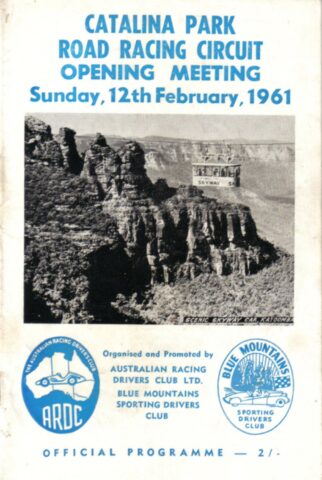
The first race meeting at Catalina Park circuit was held on the weekend of February 11 and 12, 1961. ARDC President and later life member Bill Ford wrote a welcoming article in the printed programme. He praised a group of 20 tireless workers from the Blue Mountains Sporting Drivers Club and mentioned each by name. He recalled how as early as 1954 a group from the ARDC and the BMSDC, including future World Champion Jack Brabham, had marked out what would eventually become the Catalina Park racing circuit.
A lack of finance caused a delay and construction did not begin until 1957. The residents of The Gully were removed under a council initiative and construction work was carried out every weekend for three years. As the opening meeting approached work was continued under floodlights from 7pm till 11pm every night for the last three months. Bill Ford went on to thank the Blue Mountains City Council staff for lending expensive earth moving equipment and offering valuable advice.
The opening of the Catalina Park circuit coincided with a major tourism push by the Blue Mountains City Council. The circuit joined attractions like the Scenic Railway, the Scenic Skyway and a genuine American-style drive in motel as attractions to lure tourists.
Racing operations at Catalina Park were a big challenge for the ARDC. The circuit was narrow, hilly and had no runoff whatsoever. Access to the circuit was only possible at two points – the access gates at the Tunnel of Love and the paddock exit road which joined the circuit just in front of the starting grid. Fog was a constant problem, causing late starts, timetable delays and at least one postponement of a race meeting.

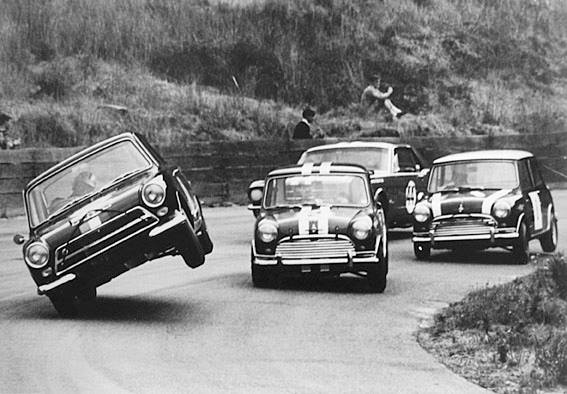
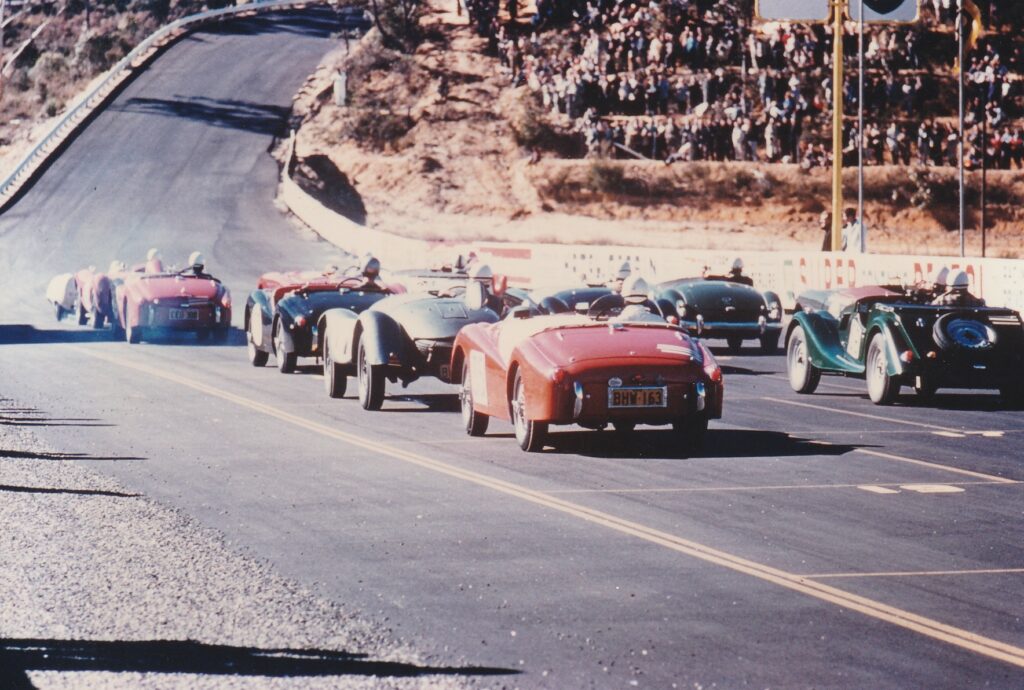
In the early years the ARDC tried to run some “big time” meetings at the mountain circuit. In October 1962 the Australian Formula Junior Championship was held at Catalina but the crowd was no bigger than normal and the formula was dead within three years. They even tried to run an international event in January 1963. The Blue Mountains International Meeting featured only one international driver – Australian Frank Gardner who had left to make his fortune in England nearly five years before. Frank raced a Brabham 1500 and a Lotus 23 1500 sports car for Alec Mildren. He finished second to Frank Matich in the main racing car event and third in the preliminary. Frank again finished second to Matich in the main sports car race after Ian Geoghegan was penalised a minute for jumping the start. Gardner was fourth in the sports car preliminary and set a new 1500cc racing car lap record of 59.7 seconds.
At the end of the 1969 season the ARDC made the decision to move its racing operations and its licenced club to the Amaroo Park circuit in the Sydney suburb of Annangrove. The Blue Mountains Sporting Drivers Club ran a meeting at Catalina in January 1970 without the help of the ARDC. I attended, not knowing at the time that this was the last Catalina race meeting. The Blue Mountains Sporting Drivers Club was disbanded shortly after.
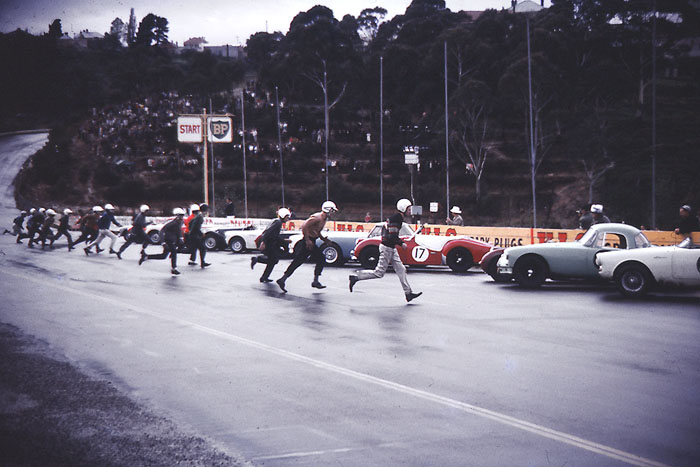
Was it dangerous?
By today’s standards it was unacceptably so. It was probably no narrower than some of today’s street circuits but the difference was at Catalina there was absolutely no run off. On more than one occasion the red flag came out at Catalina because the track was completely blocked. As mentioned previously, three drivers lost their lives at Catalina between February 1961 and January 1970. Motorcycle racing on both solos and sidecars occurred during this time but there are no records of any fatalities. Superkart racing, surely the most dangerous racing of all, continued well into the 1970s.
Inevitably the circuit lost its racing licence almost as soon as car racing stopped. It was re-configured for rallycross – the new motorsport for TV – with a dirt infield section including jumps. The first rallycross meeting was held on November 28, 1971. Rallycross was broadcast live by Channel 7, but soon the racing was dominated by Volkswagen Beetles with crazy big engines and interest waned. The circuit was used for one at a time lap dashes until 1992.
The lap record at Catalina Park is an interesting story. In the circuit map printed in every programme the length of the circuit is shown as “one and a half miles”. However, on the top of the list of lap records printed in every race programme the circuit length is shown as “one mile and 510 yards”. I think the latter length is correct. It converts metrically to 2075 metres which makes it only slightly longer than its contemporaries Oran Park (South) and Amaroo Park.
At the inaugural meeting, Frank Matich set the first outright lap record at 1 minute 02.09 seconds in his Lotus 15 sports car powered by a 2.5 litre Coventry Climax engine. This time equated to an average speed of 120.3km/h. After the last race meeting was held in January 1970 the outright lap record was still held by Frank Matich but in a later sports car – the Matich SR4 powered by a 5-litre Repco V8. The time was 53.40 seconds or 139.8km/h.
Not all that fast you may say but after walking around the circuit it seems staggering to me.
This story first appeared in the ARDC newsletter in 1995
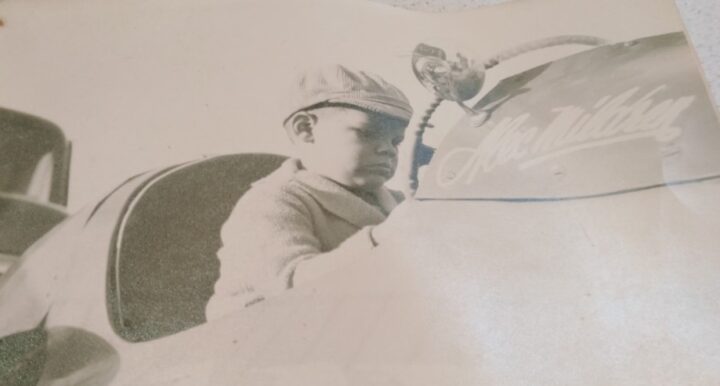
My love affair with motorsport began when my father took our family to Mount Druitt in 1955 by steam train. I was four years old. After this amazing experience I read anything on motor racing I could find and eight years later began collecting motor racing books.
In 1977 my brother raced karts with the Sydney Kart Racing Club, but I quickly learned that my severe motion sickness prevented me from joining him. My desire to be involved meant I soon found myself heavily immersed in karting administration. Over the next 15 years I worked as treasurer, clerk of the course and became a NSW Karting Council member.
In 1987 I was an internal auditor at the Caltex oil refinery when the marketing manager decided to sponsor the Alfa Romeo 75 Group A touring car driven by Colin Bond. This, I dreamed, might be a way out of bean counting. My suggestions were so positively received I was soon working in the marketing department looking after motorsport promotions and the marketing budget.
Over the next five years the Caltex race team achieved some success with the Alfa and later Ford Sierras, including third place in the 1988 Bathurst 1000 and two Australian Touring Car Championship round wins in 1990.
In June 1990 I answered an advertisement in Auto Action magazine for a motor racing administrator. No details were given other than the position was in Sydney. I was offered the Race Operations Manager job with the Australian Racing Drivers Club based at Amaroo Park Raceway. I stayed for 24 years until I retired in 2014.

